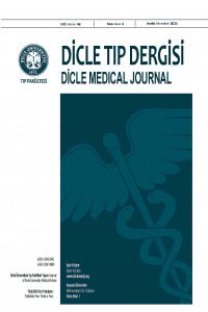Toxic epidermal necrolysis secondary to ceftriaxone use: A case report
Seftriakson kullanımı sonucu gelişen toksik epidermal nekrolizis: Bir olgu sunumu
___
- Lyell A. Toxic epidermal necrolysis: an eruption resembling scalding of the skin. Br J Dermatol 1956;68:355-361.
- Abood GJ, Nickoloff BJ, Gamelli RL. Treatment strategies in toxic epidermal necrolysis syndrome: where are we at? J Burn Care Res. 2008;29:269-276.
- Lissia M, Mulas P, Bulla A, Rubino C. Toxic epidermal necrolysis (Lyells disease). Burns 2010;36:152-163.
- Downey A, Jackson C, Harun N, Cooper A. Toxic epidermal necrolysis: Review of pathogenesis and management. J Am Acad Dermatol. 2012;66:995-1003.
- Roujeau JC, Kelly JP, Naldi L, et al. Medication use and the risk of StevensJohnson syndrome or toxic epidermal necrolysis. N Engl J Med 1995;333:1600-1607.
- Cohen S, Billig A, Ad-El D. Ceftriaxone-induced toxic epidermal necrolysis mimicking burn injury: a case report. Journal of Medical Case Reports 2009;3:9323.
- Bastuji-Garin S, Fouchard N, Bertocchi M, et al. SCORTEN: a severity-of illness score for toxic epidermal necrolysis. J Invest Dermatol 2000;115:149-153.
- Garcia DI, LeCleach L, Bocquet H, et al. Toxic epidermal necrolysis and Stevens-Johnson syndrome: does early withdrawal of causative drug decrease the risk of death? Arch Dermatol 2000;136:323-327.
- Yarbrough DR. Experience with toxic epidermal necrolysis treated in a burn center. J Burn Care Rehabil 1996;17:30- 33.
- Güneş A, Yolbaş İ, Kelekçi S, et al. Successful management of a patient with toxic epidermal necrolysis by high dose intravenous immunoglobulin. J Clin Exp Invest 2013;4:503- 505.
- ISSN: 1300-2945
- Yayın Aralığı: 4
- Başlangıç: 1963
- Yayıncı: Cahfer GÜLOĞLU
Hakan Temiz, Erdal Özbek, Serdar Toprak, Arzu Onur, Sabahattin Ertuğrul
Mustafa KORKMAZ, Cem UYSAL, Ubeydullah DURMAZ, Özgür EZİN, Özcan DEVECİ, Davut İPEK, Yılmaz PALANCİ, Nezahat AKPOLAT
Laparoskopik splenektomi klinik deneyimimiz: 38 hastanın sonuçları
Zübeyir BOZDAĞ, Ahmet TÜRKOĞLU, BEKİR TAŞDEMİR, Abdullah OĞUZ, Sinan DAL, Abdullah KARAKUŞ, Hıdır BUDAK, Metehan GÜMÜŞ
Primer mesane yerleşimli koryokarsinom olgusu
Gül TÜRKÇÜ, Ayşe Nur KELEŞ, Ulaş ALABALIK, Yaşar BOZKURT, HÜSEYİN BÜYÜKBAYRAM
Molecular epidemiology of Blastocystis
Our results of mini open approach in patients with carpal tunnel syndrome
Azad Yıldırım, Ahmet Kapukaya, Şehmus Yiğit, Ramazan Atiç, Yılmaz Mertsoy, Mehmet Çaçan
DLT çivisi uygulanan intertrokanterik femur kırıklarının tedavi sonuçları
MEHMET ARICAN, Kadir İlker YILDIZ, Zekerya Okan KARADUMAN, Mehmet Şirin BULUT, Serkan ÖZKAN
Muammer BİLİCİ, İbrahim ÖZ, Sevil İLİKHAN, Müzeyyen ARSLANER, Elif KAHRAMAN, Beyza KILAVUZ, Zeynep Özdamar, Şehmus ERTOP
Does the minor trauma during pregnancy have any effect on perinatal outcome?
Neslihan YEREBASMAZ, Derya CIRIK AKDAĞ, Şirin AYDIN, Mualla KOÇER, Fulya KAYIKÇIOĞLU, Leyla MOLLAMAHMUTOĞLU
İhsan ÇETİN, Sabahattin MUHTAROĞLU, Birsen YILMAZ, Selim KURTOĞLU
